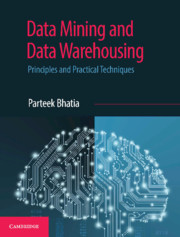Book contents
- Frontmatter
- Dedication
- Contents
- List of Figures
- List of Tables
- Preface
- Acknowledgments
- 1 Beginning with Machine Learning
- 2 Introduction to Data Mining
- 3 Beginning with Weka and R Language
- 4 Data Preprocessing
- 5 Classification
- 6 Implementing Classification in Weka and R
- 7 Cluster Analysis
- 8 Implementing Clustering with Weka and R
- 9 Association Mining
- 10 Implementing Association Mining with Weka and R
- 11 Web Mining and Search Engines
- 12 Data Warehouse
- 13 Data Warehouse Schema
- 14 Online Analytical Processing
- 15 Big Data and NoSQL
- Index
- Colour Plates
9 - Association Mining
Published online by Cambridge University Press: 26 April 2019
- Frontmatter
- Dedication
- Contents
- List of Figures
- List of Tables
- Preface
- Acknowledgments
- 1 Beginning with Machine Learning
- 2 Introduction to Data Mining
- 3 Beginning with Weka and R Language
- 4 Data Preprocessing
- 5 Classification
- 6 Implementing Classification in Weka and R
- 7 Cluster Analysis
- 8 Implementing Clustering with Weka and R
- 9 Association Mining
- 10 Implementing Association Mining with Weka and R
- 11 Web Mining and Search Engines
- 12 Data Warehouse
- 13 Data Warehouse Schema
- 14 Online Analytical Processing
- 15 Big Data and NoSQL
- Index
- Colour Plates
Summary
Chapter Objectives
✓ To comprehend the concept of association mining and its applications
✓ To understand the role of support, confidence and lift
✓ To comprehend the Naïve algorithm, Its limitations and improvements
✓ To learn about approaches for transaction database storage
✓ To understand and demonstrate the use of the apriori algorithm and the direct hashing and pruning algorithm
✓ To use dynamic Itemset counting to identify association rules
✓ To use FP growth for mining frequent patterns without candidate generation
Introduction to Association Rule Mining
Association rule mining often known as ‘market basket’ analysis is very effective technique to find the association of sale of item X with item Y. In simple words, market basket analysis consists of examining the items in the baskets of shoppers checking out at a market to see what types of items ‘go together’ as illustrated in Figure 9.1.
It would be useful to know, when people make a trip to the store, what kind of items do they tend to buy during that same shopping trip? For example, as shown in Figure 9.1, a database of customer transactions (i.e., shopping baskets) is given where each transaction consists of a set of items (i.e., products purchased during a visit). Association rule mining is used to identify groups of items which are frequently purchased together (customers’ purchasing behavior). For example, ‘IF one buys bread and milk, THEN he/she also buys eggs with high probability.’ This information is useful for the store manager for better planning of stocking items in the store to improve its sale and efficiency.
Let us suppose that the store manager, receives customer complaints about heavy rush in his store and its consequent slow working. He may then decide to place associated items such as bread and milk together, so that customers can buy the items easier and faster than if these were at a distance. It also improves the sale of each product. In another scenario, let us suppose his store is new and the store manager wishes to display all its range of products to prospective customers.
- Type
- Chapter
- Information
- Data Mining and Data WarehousingPrinciples and Practical Techniques, pp. 229 - 318Publisher: Cambridge University PressPrint publication year: 2019



